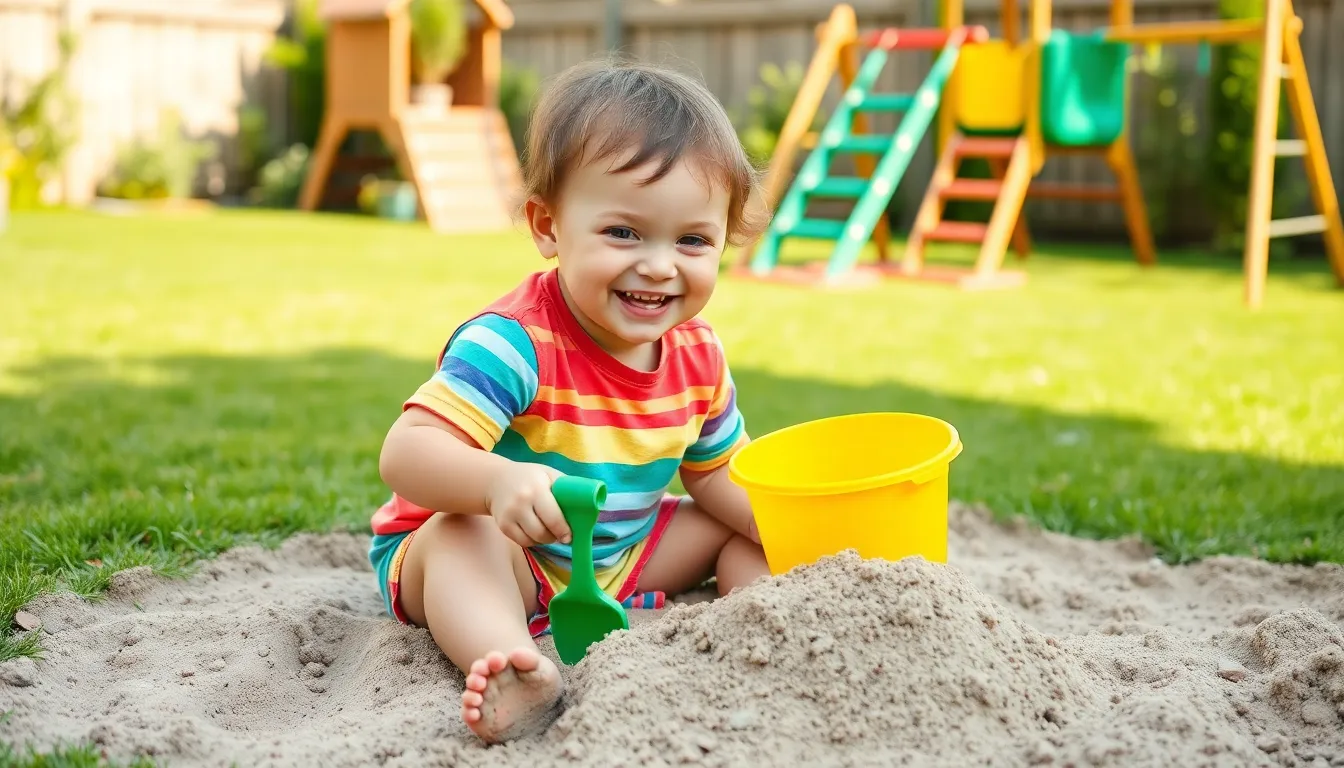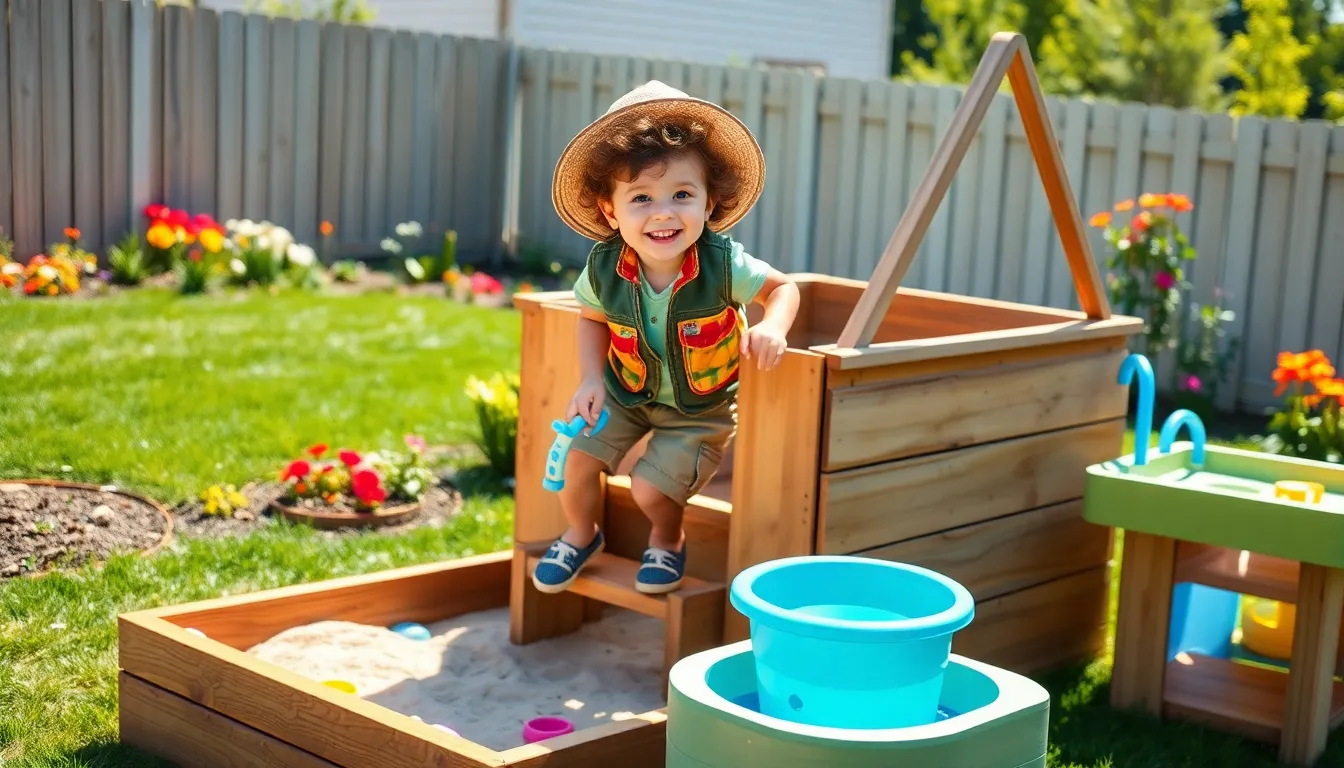When it comes to toddler backyard play, the backyard transforms into a magical kingdom where imagination reigns supreme. Picture this: tiny explorers in capes, wielding foam swords, and conquering the treacherous terrain of grass and garden gnomes. It’s not just play; it’s a full-blown adventure that fuels creativity and builds confidence, all while keeping parents on their toes!
Table of Contents
ToggleBenefits of Toddler Backyard Play
Toddler backyard play offers various advantages for young children. Engaging in outdoor activities helps them explore new environments while developing essential skills.
Physical Development
Physical development significantly improves through backyard play. Activities like running, climbing, and jumping enhance gross motor skills. Toddlers strengthen their muscles and coordination as they navigate play structures or chase after bubbles. According to the American Academy of Pediatrics, children require at least 3 hours of physical activity daily. Backyard play provides a perfect setting for meeting this guideline. Children gain balance and agility from outdoor games, contributing to their overall health and well-being.
Social Skills Enhancement
Social skills enhancement occurs naturally during backyard play. Interactions with peers foster essential communication abilities. Sharing toys and taking turns cultivates cooperation among toddlers. Conflict resolution also takes place as they navigate play dynamics, helping them develop empathy. Participating in group games encourages teamwork and builds lasting friendships. The backyard environment creates a safe space for toddlers to practice these important social interactions.
Types of Toddler Backyard Play

The backyard offers an exciting array of play opportunities for toddlers. Various types of play engage their minds and bodies, fostering development in numerous ways.
Active Play
Active play encompasses physical activities that boost gross motor skills. Toddlers love running, jumping, and climbing on structures, which enhance coordination and strength. They can explore designated play areas or climbing frames designed for their age group. Engaging in these activities meets the American Academy of Pediatrics’ recommendation of at least 3 hours of physical activity each day. Incorporating games like tag or obstacle courses encourages social interaction and teamwork. This play type not only develops physical health but also reinforces confident movement as kids gain more control over their bodies.
Creative Play
Creative play allows toddlers to express their imaginations freely. Simple materials, such as buckets, shovels, and art supplies, invite exploration and invention. Through activities like building sand castles or drawing with sidewalk chalk, toddlers develop important cognitive skills and problem-solving abilities. Pretend play thrives in backyards; children often role-play as pirates or astronauts, giving them agency over their stories. This imaginative engagement fosters creativity while building emotional resilience. Environments that encourage creative expression enhance their ability to interact with their surroundings and contribute positively to social environments.
Safety Considerations
Safety remains a top priority when toddlers engage in backyard play. Proper precautions ensure a secure environment for playtime adventures.
Choosing Safe Equipment
Selecting the right equipment is crucial. Parents should prioritize age-appropriate toys and structures. Soft materials provide added protection against injuries. Additionally, ensure items lack sharp edges or toxic components. Resilient surfaces like rubber mulch and grass can cushion falls, reducing risks. Regular maintenance helps keep equipment in good condition, ensuring safety remains intact.
Landscape Safety
A safe landscape minimizes hazards. Parents must inspect their yards for potential dangers. Remove sharp objects like rocks or branches to prevent injuries. Organic, untreated plants are ideal for avoiding harmful chemicals. Enclosed play areas can help keep toddlers safe and prevent wandering. Fencing also acts as a barrier against outside dangers, like pets or traffic. Regularly mowed grass reduces hidden insects and allergens, creating a healthier play environment.
Encouraging Toddler Backyard Play
Encouraging toddler backyard play involves creating enticing environments where children can explore and develop skills. Engaging spaces stimulate imagination while providing safe areas for fun.
Setting Up Engaging Spaces
Parents can design vibrant play areas with colorful equipment and natural elements. They might introduce a small climbing structure, a sandbox, or a water play station. Each addition invites active exploration and imaginative play. Incorporating open spaces allows toddlers to run freely, enhancing their gross motor skills. Planting flowers or vegetables creates sensory experiences, sparking curiosity about nature. It’s essential to place soft flooring materials, like rubber mats or grass, to cushion falls. In particular, shaded areas protect toddlers from the sun, ensuring comfort during playtime.
Outdoor Activities and Games
Fun outdoor activities promote both physical and social development. Parents can organize games like tag or hide and seek, fostering teamwork and communication skills. Activities such as hopscotch or obstacle courses encourage gross motor skills and foster coordination. Simple gardening tasks can involve toddlers while teaching them about responsibility and nurturing. Crafting scavenger hunts enhances exploration, inspiring curiosity about the yard’s ecosystem. Outdoor art projects using leaves or rocks nurture creativity while integrating sensory play. Ultimately, structured and unstructured games contribute to a well-rounded play experience, essential for toddlers’ growth.
Toddler backyard play is a vital component of early childhood development. It provides a unique space for children to explore their creativity while enhancing their physical and social skills. By engaging in active play and imaginative scenarios, toddlers build confidence and resilience in a safe environment.
Creating a well-designed backyard play area not only encourages these activities but also fosters a deeper connection between parents and their children. With the right safety measures and stimulating elements in place, parents can ensure their toddlers enjoy countless hours of enriching play. Embracing the magic of backyard adventures sets the stage for lifelong learning and growth.




